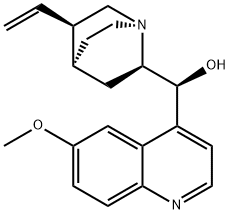Quinine , 97% , 130-95-0
Synonym(s):
(-)-Quinine;6′-Methoxycinchonidine;6-Methoxy-α-(5-vinyl-2-quinuclidinyl)-4-quinolinemethanol;Quinine
CAS NO.:130-95-0
Empirical Formula: C20H24N2O2
Molecular Weight: 324.42
MDL number: MFCD00198096
EINECS: 205-003-2
| Pack Size | Price | Stock | Quantity |
| 25G | RMB127.20 | In Stock |
|
| 100G | RMB479.20 | In Stock |
|
| 500g | RMB1983.20 | In Stock |
|
| others | Enquire |
PRODUCT Properties
| Melting point: | 173-175 °C(lit.) |
| alpha | -172 º (c=1, EtOH) |
| Boiling point: | 462.75°C (rough estimate) |
| Density | 1.1294 (rough estimate) |
| bulk density | 110-140kg/m3 |
| vapor pressure | 0Pa at 25℃ |
| refractive index | 1.6250 (estimate) |
| Flash point: | >110°C (>230°F) |
| storage temp. | Keep in dark place,Inert atmosphere,Room temperature |
| solubility | H2O: soluble |
| pka | 8.52(at 25℃) |
| form | Crystalline Powder |
| color | White |
| PH | 9.0 (0.5g/l, H2O, 20℃) |
| PH Range | Blue I uorescence (3.0) to weak violet I uorescence (5.0);Weak violet I uorescence (9.5) to nonI uorescence (10.0) |
| optical activity | [α]25/D 165°, c = 2 in ethanol |
| Odor Type | odorless |
| Water Solubility | slightly soluble |
| Sensitive | Light Sensitive |
| Hydrolytic Sensitivity | 2: reacts with aqueous acid |
| Merck | 14,8061 |
| BRN | 91867 |
| Major Application | Bird repellents, sunscreen, antimalarial agent, antiviral agent, antitumor agent, drug-coated coronaryagent, antiparasitic agent, treatment of epilepsy, skeletal muscle spasm, drug-coated coronary stent system |
| LogP | 3.17 at 25℃ |
| CAS DataBase Reference | 130-95-0(CAS DataBase Reference) |
| NIST Chemistry Reference | Quinine(130-95-0) |
| EPA Substance Registry System | Quinine (130-95-0) |
Description and Uses
Quinine, was the first known antimalarial. It is a 4-quinolinemethanol derivative bearing a substituted quinuclidine ring. The use of quinine in Europe began in the seventeenth century, after the Incas of Peru informed the Spanish Jesuits about the antimalarial properties of the bark of an evergreen mountain tree they called quinquina (later called cinchona, after Dona Franciscoa Henriquez de Ribera [1576–1639], Countess of Chinchon and wife of the Peruvian Viceroy).
Quinines use as an antimalarial agent spans several hundred years, but it has been replaced in recent years by other substances such as chloroquine. Because some Plasmodium strains have developed resistance to several malaria medications, quinine use is being revived. About 60% of quinine production is used for medicinal purposes, and the drug is available by prescription. In addition to its use as an antimalarial agent, quinine medications are used to treat leg cramps, muscle cramps associated with kidney failure, hemorrhoids, heart palpitations, and as an analgesic. At higher concentrations it is toxic and causes a condition known as cinchonism. Conditions associated with cinchonism include dizziness, hearing loss, visual impairment, nausea, and vomiting.
Nonmedicinal use of quinine, accounting for about 40% of its use, is primarily as a fl avoringagent in condiments and liqueurs. The most common food use of quinine is tonic water. Tonicwater originated in India where English colonists drank carbonated water mixed with quinineto prevent malaria. The bitter taste of quinine was often masked by mixing it with alcoholicbeverages; one result of this practice was the drink gin and tonic. Current Food and DrugAdministration regulations in the United States limit the amount of quinine in tonic water to83 parts per million (83 mg per liter). This level is signifi cantly less than that required for therapeuticpurposes, so the use of commercial tonic waters to combat malaria is not practical.
Safety
| Symbol(GHS) |  GHS07 |
| Signal word | Warning |
| Hazard statements | H302-H317 |
| Precautionary statements | P261-P264-P280-P301+P312+P330-P302+P352-P333+P313 |
| Hazard Codes | Xn,Xi |
| Risk Statements | 36/37/38-42/43-22-20/22-20/21/22-36/38 |
| Safety Statements | 22-26-36/37-45-37/39-36-7 |
| RIDADR | 1544 |
| WGK Germany | 3 |
| RTECS | VA6020000 |
| F | 8 |
| HazardClass | 6.1(b) |
| PackingGroup | III |
| HS Code | 29392110 |
| Hazardous Substances Data | 130-95-0(Hazardous Substances Data) |
| Toxicity | Antimalarial still used primarily for treatment of plasmodium resistant to synthetic antimalarials. Also used as antipyretic for colds, influenza, and cramp; quinine may have toxic effects on the eye, apparently due to an immune reaction, and may also affect male reproductive capacity. |




